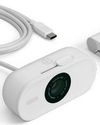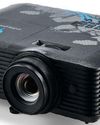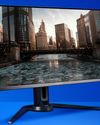
BE CAREFUL WHAT you ask for—you might just get it. So it goes with screen technology of late. We’ve been clamoring for something better than an LCD panel with a big, dumb backlight for years. Now we’ve got it, and it turns out—in some ways, at least—that conventional LCD monitors aren’t so bad after all.
The new entrants on the display scene are, of course, miniLED and OLED. Mini-LED screens are actually a subset of LCD displays, not a new category of panel tech. But they do represent a significant step change. OLED, meanwhile, has taken its time transitioning from the TV market to PC monitors. But it is a radical new technology and has finally arrived in desktop monitors.
On paper, both offer dramatic advantages over conventional LCD displays. At last, you can have true HDR performance, perpixel lighting, rapid response times and several other hitherto unobtainable screen attributes. In practice, however, they are turning out to be rather more problematic than predicted.
Put it this way: we’ve seen numerous examples of the latest mini-LED and OLED monitors, and we’re not sure we’d take any of them over the best available conventional LCD panels.
There are a couple of caveats to that, which we’ll come to. But along the way, we need to identify what exactly the problems with mini-LED and OLED monitors are, ask if they can be fixed and consider if there are any alternative technologies that entirely sidestep all the issues. Let’s get to it.
This story is from the May 2023 edition of Maximum PC.
Start your 7-day Magzter GOLD free trial to access thousands of curated premium stories, and 9,000+ magazines and newspapers.
Already a subscriber ? Sign In
This story is from the May 2023 edition of Maximum PC.
Start your 7-day Magzter GOLD free trial to access thousands of curated premium stories, and 9,000+ magazines and newspapers.
Already a subscriber? Sign In

Google Gemini vs. ChatGPT
Which LLM currently holds the crown?

Frostpunk 2
Endure a blizzard of tough choices and lasting consequences in the survival city builder sequel

Elgato Facecam Neo
Always sees us in the best light but lacks focus: 8/10 boyfriend, er, camera

Elgato Wave Neo
The Kanye West of mics: Easy to get into, but a little weird

Razer BlackWidow V4 75%
Solid and compact, with hot-swappable switches

Razer Wolverine V3 Pro
Razer's pro controller is even better than Microsoft's

Acer Predator GM712
2008 called, it wants its projector back

AndaSeat Kaiser 4 XL
A chair as big and as comfortable as they come

Gigabyte F027Q2
Speed is of the essence with this OLED screen

Acer Nitro 14
AMD puts on a good show, but it still lacks punch